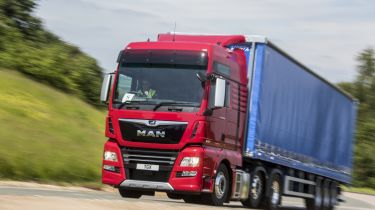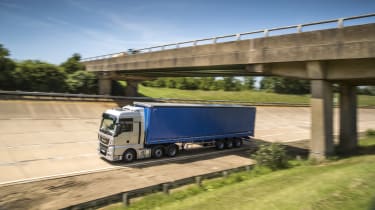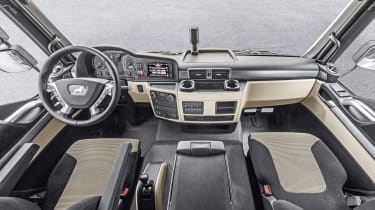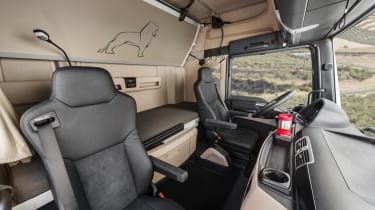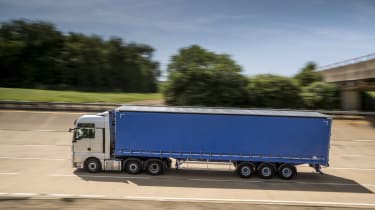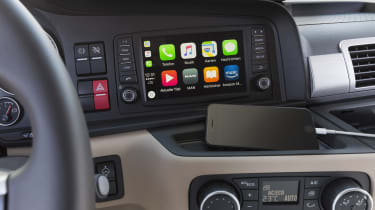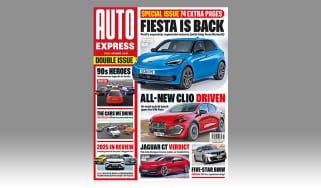What's it like to be an HGV driver?
We get behind the wheel of 18 and 44-tonne lorries to get a car driver's perspective on driving one of these UK highway heavyweights
It's one of the most demanding jobs on the road, but what's it really like to be a truck driver in the UK? To find out, and offer some perspective for the average car driver's point of view, Auto Express joined leading truck maker MAN Truck & Bus at Millbrook Proving Ground in Bedfordshire for its annual range day to get a taster of driving some of the biggest vehicles on the road.
Because Millbrook is a closed test facility, it's possible to drive vehicles that your existing driving licence won't normally allow. In this instance, that means the 3.5-tonne maximum weight limit that a standard car driving licence limits you to is no longer applicable, giving us the perfect opportunity to try something bigger.
MAN sells a range of heavy goods vehicles to suit a variety of needs. The range kicks off with the VW Crafter-based MAN TGE panel van, then moves through 7.5-tonne to 26-tonne fixed-axle models called the TGL and TGM, then there are the larger trucks, the TGS and TGX, which are for sale as chassis cabs or articulated semi-trailer models. These are the machines that are capable of hauling the maximum gross vehicle weight allowed on UK roads, which is 44 tonnes.
For its range day, MAN had its full model line-up available to try out, including the biggest articulated tractor-trailer HGV units, eight-wheel drive cement mixers and tippers on an off-road course and even its luxury coaches, which are another kind of driving experience altogether: there are a clear 9 metres of vehicle between the driver - who sits ahead of the front wheels - and the engine, which makes it unlike anything else on the road to drive. Thankfully, the wide-open spaces of Millbrook's test facility and the fact these were MAN's demonstrators meant we could try these machines in relative safety, considering the biggest vehicle we've driven before was a large van.
What's it like to drive an 18-tonne lorry?
For our first experience of HGV driving, we decided to go (relatively) small with the 18 tonne MAN TGM, featuring two axles and a curtain side body. It's the kind of truck you'll see delivering in towns and to DIY centres across the UK, with sliding side curtains to access the load area, making it easy for forklifts to unload pallets.
The first job before driving is to actually get into the cab. There are two steps up to the driver's seat, which sits around 8 feet off the ground, and once sitting in place, it's clear that the cab is made with comfort in mind. MAN offers suspended seats for improved comfort, for starters. These feature air suspension that's designed to absorb bumps as you're driving along, and work independently from the truck's suspension. It can deliver greater comfort, but sometimes it gives you a bobbing sensation that could make sensitive passengers feel queasy.
Once you're sat down, the view ahead doesn't feel much different to a high-riding SUV or van. Yes, you're sat a lot higher, but not so much that it feels alien. But then somebody walks in front of the truck and you realise how much you can't see immediately in front of you. Sitting 10 feet off the ground with a dashboard ahead of you creates a blind spot that's easily big enough for a car to disappear into, which is why most trucks today come with additional wide-angle mirrors pointing down at that part of the truck to give you a better view.
This is in addition to a mirror over the nearside door to help you position the truck as close to the kerb as possible, plus the large wing mirrors. These are in two parts with standard and wide angles, and are simply massive, which means the view out the back is nearly as good as the view forward. As it turns out, this is particularly important.
In front of the driver is a large steering wheel in a traditional flat 'dinner plate' layout, which sits on top of a chunky steering column that you have to straddle with your feet. As a result, there are only two pedals to negotiate with your right foot, as there's no foot-operated clutch to contend with - the entire MAN Truck range is automatic, so there's no complex gear selection going on.
Indeed the gear selector is a rotary switch mounted low on the vast centre console. It has two forward and two reverse settings, with standard ratios or the equivalent of low-range gears for when the truck is loaded up. All you do is move the switch to 'D', and the gearbox electronics select the optimal gear to pull away. After that, release the hydraulic handbrake and you're off.
There's a 6.9-litre six-cylinder diesel beneath you packing 247bhp, 286bhp or 316bhp, as well as 1,050-1,250Nm of torque, but thanks to the truck's weight and multiple gears, progress from standstill is sedate, and you gather momentum rather than launch off the line. That's fine because it gives us enough time to get used to the way the TGM drives.
The large steering wheel needs more turns to go from lock-to-lock than a car, while your position above and slightly ahead of the front wheels means you need to recalibrate as to when you should turn - leave it late, otherwise you'll end up steering off the road or into the opposing lane. There's no such thing as feedback, either - the steering isn't heavy thanks to plenty of power assistance, but that also means the steering points the truck where you want to go, rather than offering any communication to let you know what the wheels are doing. But then a truck is designed for work rather than play.
Another big difference between a car and a truck are the brakes. With hydraulic assistance ready to kick in whenever you hit the pedal, there's no progression to be had with the truck. It means you need affirmative input on the pedal, and if you want to slow gradually, then there's heavy reliance on engine braking instead.
On the move, you're aware that you're sitting higher than other traffic around you, but it soon becomes natural, and you tend to look further up the road because of the high seating position, allowing you to anticipate what's going to happen. In fact, you're more likely to be looking behind you, thanks to those vast mirrors. As they're mounted away from the truck's bodywork, they allow you to see the whole side of the truck from the wheels up, giving you all the info you need on your position. During our time driving the 18-tonne TGM, we spent around half the time checking the mirrors, with extra attention being paid when turning out of junctions.
Overall, driving an 18-tonne truck is pretty straightforward. The auto box does all the hard work of keeping you in the power band, so all you need to do is get used to the sheer size of the truck when on the open road. Junctions need a bit more attention, but with those vast mirrors helping you to see all around you, positioning the truck to avoid kerbs and other objects is relatively simple.
What's it like to drive an articulated truck?
With our first taste of trucking under our belt, it's time for the heavy hitter, this time in the shape of the MAN TGX. This is MAN's heavy-haulage truck, and it comes in three cab styles (XL, XLX, XXL) and an engine range from 9.0 to 15.2 litres that offer 325 to 631bhp, and torque figures from 1,600 to 3,000Nm.
MAN claims that this is its most efficient truck yet. The version we drove had a 460-litre fuel tank, so that's around £600 to fill, probably more if you're at motorway services. There's a 24-litre AdBlue tank to help reduce emissions, too.
We tried the mid-range 12.4-litre six-cylinder diesel with 493bhp and 'only' 2,500Nm of torque. It comes with a 12-speed Tipmatic auto gearbox, which looks after gearchanges so smoothly that all you need to worry about is your surroundings.
Driving an articulated truck needs even more planning. There's a vast trailer behind you, but again the mirrors are so good that you can see everything that's happening to the rear, and the separate tractor unit and trailer mean it's more manoeuvrable than you'd imagine.
Like all trucks, this arctic unit is limited to 60mph, and when cruising around Millbrook's famous bowl, it was an easy ride. However, that's with other professional drivers on course and without the threat of traffic and erratic driving to contend with. Thankfully, the large cab and optional air-suspension smooth things out nicely, while travelling at motorway speeds sees the engine cruising barely above idle to help boost fuel economy.
On Millbrook's twisty Hill Route, the TGX felt stable and powerful, and it also showed off one of its party tricks. EfficientRoll is a system that allows you to save fuel while coasting, especially downhill. All you have to do is accelerate to your desired speed on an uphill section, and once you have crested the hill, lift off the throttle and the truck will maintain the same speed while rolling in neutral. And it doesn't use the brakes to maintain speed, instead using exhaust gases to boost engine braking, thus reducing wear and tear on the truck's mechanical parts. Also available is EfficientCruise, which is an intelligent cruise control system that use GPS to plan gear changes in advance of descents and inclines in an effort to save even more fuel.
The TGX we drove was an XXL cab model, which is designed for living in, so it's relatively plush. There are two beds with plenty of storage, while the spacious cab has lots of drinks holders, cubbies, trays and drawers for all your kit. The dashboard itself is relatively utilitarian, but everything is logically laid out, and because MAN is part of the VW Group, it uses navigation software that will look familiar to anybody who's driven a VW, SEAT or Skoda in recent years.
Our time at the wheel helped us see that these giants of the road do need some co-operation from other road users. Even though there are plenty of mirrors, it's still hard to judge where the rear of the truck is - which is why you see truckers flashing their lights to let each other in or out. And driving long distances is all about maintaining momentum, so if you see a truck attempting to pull out ahead of you, give them space - they'll save fuel by keeping going, and you'll only be inconvenienced for the shortest time. And always give trucks room at junctions. They might see you, but they still need the space to turn, so give them a wide berth, especially when they're reversing.
What licence do you need to drive a lorry in the UK?
There are four driving licence categories that cover driving a heavy goods vehicle (HGV) - C1, C1E, C and CE. Category C1 is for HGVs weighing 3.5 to 7.5 tonnes, while a Category C licence is for anything over 3.5 tonnes. C1E and CE licences allow you to drive the aforementioned lorries, but with a trailer over 750kg, and it's this last licence you need to drive an articulated truck.
To qualify for an HGV licence, first you need to have a full car licence and be over 18 years of age. Then you need to get a Driver Certificate of Professional Competence (CPC), a professional driving qualification that requires you to pass four tests before you can drive an HGV.
Like a car licence, there is a provisional licence to apply for, then you can take the four parts of the test: theory, case studies, driving ability and practical. Once you've passed the CPC, you'll get a CPC card which you must carry with you when you are driving. On top of these tests, you need to take another 35 hours of training every 5 years to retain your CPC.
In all, it costs around £275 in licence fees, while you should budget around £1,000 for training with an accredited company, which will usually take the form of a 5-day intensive course. If you want to drive a bus or coach, then there's another test you need to take, the Category D and DE tests, which are independent of the HGV test.
There are numerous companies out there offering HGV driver training and finding the best solution for you can be tricky. According to Paul Weller, Managing Director of TrainingMentor.co.uk, it pays to avoid the online brokers who simply pass your booking on to training companies and you should always visit the actual training provider before booking. Where possible, take a driving assessment so an instructor can determine the kind of tuition you need and give you a personalised quote.
Finally, Paul advises that you shouldn’t be swayed by high advertised pass rates. “The national average pass rate is approximately 55%, and a good first-time pass rate for an HGV training provider is 75%. Anything over 90% should be viewed with suspicion”, he said.
Find a car with the experts

